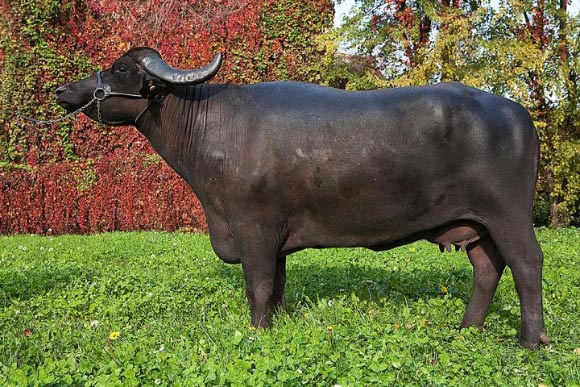A multinational consortium of scientists has produced the first high-quality genomic sequence for the river buffalo (Bubalus bubalis bubalis), an important species for agriculture and local economies.

This is Olimpia da Farfengo, the female Mediterranean water buffalo that the researchers sequenced. Image credit: Caterina Cambuli.
The water buffalo is a key species for smallholder producers in developing countries, and an important resource for specialized markets.
Domestic buffaloes have a global distribution and are found in 129, mainly tropical and sub-tropical, countries. They contribute to the rural economies, especially in Asia, and in many regions where buffalo are more important than cattle.
The world population of buffalo is about 195 million compared to more than 1.4 billion cattle, 1 billion sheep and 500-600 million goats.
There are two types of domestic water buffalo, the river buffalo (B. b. bubalis) which has a global distribution, but are the predominant type found in the west from India to Europe.
The second type, the swamp buffalo (B. b. carabanensis), is found more frequently in the eastern Asian countries, particularly from India through China, Indonesia and the Philippines.
“Water buffaloes were domesticated about 5,000 years ago, and since then have been of economic importance for milk, meat and as a work animal around the world,” said consortium leader Professor John Williams, from the University of Adelaide, Australia.
“They are particularly important in developing countries and, in specialized markets, they provide milk for products such as mozzarella cheese in Italy. The water buffalo is a key agricultural animal because it is able to adapt to diverse environments, and is particularly tolerant of disease.”
Professor Williams and co-authors sequenced the genome of the river buffalo, which have been selected for milk production through organized breeding programs in Italy, India, the Philippines and Brazil.
“The publication of the buffalo genome provides the essential reference point for studies on the molecular genetics of the buffalo,” Professor Williams said.
“It will help breeders to enhance commercially desirable characteristics in the water buffalo, and researchers and conservationists to preserve the diversity of buffalo populations.”
“It is also possible to compare the buffalo genome with that of other species to understand differences in the biology of buffalo and their ability to adapt to a wide variety of environments,” said Dr. Daniela Iamartino, R&D Technical Manager at the Italian Breeder Association’s Laboratory of Genetics and Services.
“The annotation of the genome identifies the genes present to explore their function and study the differences among species.”
The researchers reported their results and analysis in a pair of papers in the journal GigaScience and the journal PLoS ONE.
_____
John L. Williams et al. 2017. Genome assembly and transcriptome resource for river buffalo, Bubalus bubalis (2n = 50). GigaScience 6 (10): 1-6; doi: 10.1093/gigascience/gix088
D. Iamartino et al. 2017. Design and validation of a 90K SNP genotyping assay for the water buffalo (Bubalus bubalis). PLoS ONE 12 (10): e0185220; doi: 10.1371/journal.pone.0185220







